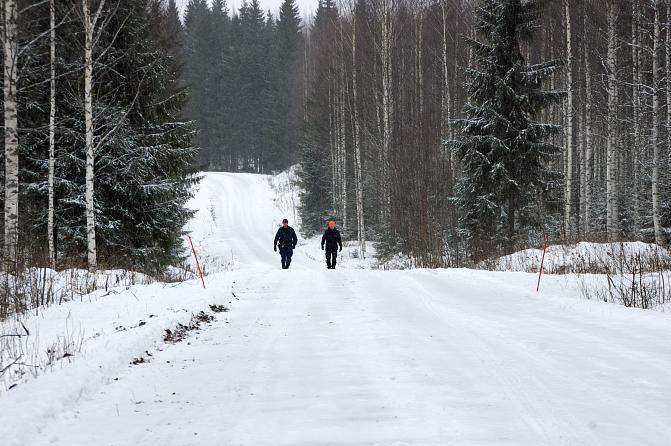The fourth year of the LIFE BOREALWOLF patrol
Authors: Harri-Pekka Pohjolainen (Eastern Finland Police Department), Henri Pelkonen (Metsähallitus)

The tasks of the wildlife patrol in the LIFE BOREALWOLF project:
- Diverse cooperation and interaction with different stakeholders and citizens, for example by providing guidance and advice and low-threshold consultation to reduce, mitigate and eliminate various conflicts. These activities aim to reduce the negative impacts of wolves, such as fear, anxiety, anger, and frustration with the authorities.
- To carry out a wide range of general surveillance, especially in sparsely populated areas, including road and off-road surveillance (sparse surveillance).
- To carry out targeted enforcement in areas where, for example, there has been a history of illegal killing of large carnivores.
- Management of conflicts involving large carnivores in cooperation with the different actors involved in game management in the area (Finnish Wildlife Agency, game management associations, and the LCO and LGOH networks).
- Communication and dissemination of fact-based information (social media and various fairs and events).
Surveillance
In terms of general surveillance, the focus throughout the project (from 1 December 2019) has been on hunting surveillance, focusing mainly on the licensing of hunting, possession of firearms and hunting methods used in connection with licensed hunting, such as road hunting of small game and the transport of weapons in vehicles. The focus of traffic control has been on drink-driving enforcement. Off-road traffic and fisheries control have also been carried out in addition to the basic task.
Targeted enforcement has been focused in particular on areas where wolves are known to be present and where a risk assessment suggests that wolves and other large carnivores are or may be targeted for illegal killing. Targeted enforcement is a tool used by enforcement authorities to prevent, detect and combat serious and sometimes organised hunting crime, in particular in relation to large carnivores.
The surveillance has been focused in the North Karelia region, but increasingly also on the North Savo region. Individual shifts have also been allocated to the Oulu police station (Kainuu) in cooperation with other enforcement authorities.
The wildlife patrol has mainly carried out surveillance on its own, but also in cooperation with other surveillance authorities in the area (Metsähallitus, the Eastern Finland Police, Customs and the Border Guard). Bear, moose and grouse hunting has been surveyed through cooperation, some national and some local thematic efforts.
Cooperation in surveillance with the different authorities is very important, as it will allow us to further develop cooperation between authorities, especially in detecting and combating serious hunting crime. As the resources of the different authorities in Finland are limited, cooperation is the best way to increase cooperation in both surveillance and criminal investigation in a significant way. This will enable the authorities to increase the risk of being caught and to improve the effectiveness of criminal liability. And there are also excellent examples of this, such as the suspected criminal case in Lapinlahti.
In the area of the Eastern Finland Police Department, the surveillance carried out by the wildlife patrol forms the backbone of wildlife surveillance, on top of which other wildlife surveillance is built on a situation- or theme-specific basis. Without the patrol’s main activity, the prevention of hunting offences and the detection and suppression of hunting offences in the territory of the Eastern Finland Police Department would be significantly weakened. Even one full-time patrol can significantly increase the ability and performance of the unit’s territory to prevent and detect hunting crime, when it is carried out in a planned, managed and cooperative manner.
Monitoring
The activity of the patrol is reported in a separate monitoring system. The reports summarise the main tasks and surveillance activities of each shift. Here are some monitoring data for the period 1.1.2020 – 31.12.2023:
- vehicles checked during the inspection: 1034
- hunting and weapons permits checked during the inspections: 840
- drunk drivers encountered: 5
- performed exhalation tests on drivers: 682
- number of criminal reports (hunting offences / offenses): 42
- other offences and violations revealed during surveillance: 81
- Alert tasks performed (nearest free patrol): 55
- collected DNA samples: 45
- tips from the citizens: 95
- collaboration actions with other surveillance authorities: 93
- information sharing: 29
- assisting in inspections of carcasses: 52
- fishing surveillance tasks: 162
Conflict management and assisting citizens
During the year, the patrol’s working time was focused on preventing and mitigating damage to domestic and farm animals caused by wolves and other large carnivores. The Patrol consulted, guided and advised citizens on how to reduce and prevent conflicts, for example in situations where a bear had caused damage to beehives. The autumn of 2023 was particularly difficult in the North Karelia region due to repeated damage to domestic and farm animals.
The discussion topics of the encounters with local residents vary according to the time of year. During the snowy season, wolf visits to the yard are the main concern. In summer and autumn, encounters often involve inspecting damage caused by wolves. Based on the direct feedback received, citizens have been satisfied with the patrol’s performance on the tasks in question.
The number of contacts from citizens regarding various conflicts is expected to continue to increase in the future, as the prohibition of the large carnivore management hunt in Finland will lead to an increase of all large carnivore populations in the coming years. Residents in the area have found that the patrol and other project actors are able to help them in a variety of ways to prevent and manage conflicts.
Stakeholder collaboration and training activities
During the year, the wildlife patrol engaged in a wide range of cooperative activities with various stakeholders and authorities, including enforcement authorities. The main stakeholders were the Finnish Wildlife Agency, Natural Resources Institute Finland and the game management associations in the region, and their respective large carnivore observers. The cooperation focused on updating the situation of the large carnivores in the region, as well as preventing and mitigating conflicts. During the autumn, the patrol also worked with some game management associations during the surveillance of the moose hunt.
The project was presented in a seminar organised by the National Police Board on wildlife surveillance and enforcement. The project presented the patrol work and the final version of the surveillance tool developed by the project to some 70 enforcement officers.
During spring, one member of the wildlife patrol contributed significantly to the investigation of the criminal case of “Saukukko”. Case Savukukko is the largest and most serious large carnivore-related crime in Finnish criminal history so far and will be prosecuted during the spring of 2024. The patrol has also supported investigations into other hunting crimes in their operation area during the year.
There was also international cooperation during the year. In November, the patrol was accompanied by a Swedish game warden who was introduced to the work of the patrol and wildlife surveillance work in general in Finland.
Information sharing
In September, the wildlife warden (one member of the patrol) wrote a blog post on the project webpage on visiting livestock farms. TH large number of sheep damages was in the headlines in late summer, and the blog brought a farm-based perspective on livestock protection into the discussion.
Many themes on surveillance were covered during the live broadcast on Yle Arena on 12 October 2023, produced as a collaboration between the national broadcast company and the project. Themes like wolf yard visits, the definition of when wolves cause concern, threat or danger and how the responsibilities of the authorities are divided were discussed.
As usual, the debate around the wildlife patrol’s activities intensified at the end of the year, especially in social media. There was public debate on issues such as what kind of attention colouring is required during hunts and how much the offence should be fined. A second complaint was put forward to the Ombudsman of the parliament about the involvement of the Eastern Finland Police Department in the project.
In November, the patrol was accompanied by a Swedish journalist who wrote an article about the wolf conflict in Finland and the Wildlife patrol for the second largest Swedish newspaper, Göteborgsposten, and a separate article for the Police magazine in Sweden. Both articles were also published online.
Kuopio, 24.1.2024
Harri-Pekka Pohjolainen
Detective Inspector
Eastern Finland Police Department
Henri Pelkonen
Head of Wildlife Surveillance
Metsähallitus




